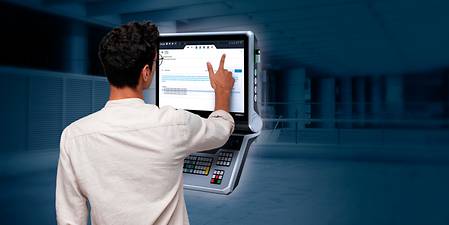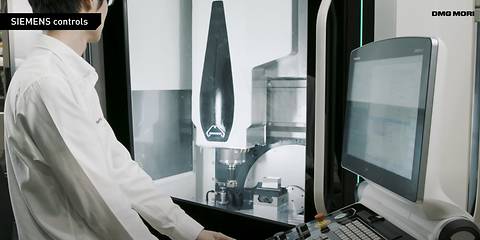CNC Controls
Machining Transformation (MX) marks the transition to networked, digitized and sustainable CNC manufacturing. At the heart of this revolution are the four core areas of Process Integration, Automation, Digital Transformation (DX) and Green Transformation (GX). In this holistic context, the CNC control acts as a source of digital manufacturing intelligence and is of existential importance for the further development of manufacturing technology in the age of industrial digitization.
The age of modernity began for the global machine tool industry at MIT (Massachusetts Institute of Technology), a renowned university in Cambridge. The first NC machine was developed there in the late 1940s and early 1950s. It was triggered by the search for an efficient solution for manufacturing complex workpieces for the aerospace industry. The abbreviation “NC” stands for the numerical control of machines. This development is considered a significant turning point in the history of machine tools. However, there was still a long way to go before the evolution of the NC to the CNC control and the associated breakthrough in the use of computers.
The evolution from NC to CNC controls
In the years following their world premiere, NC systems had to overcome several challenges and limitations. One of the biggest hurdles was their limitation to individual tasks and static operations. Since they were programmed to perform a specific action, it was difficult and time-consuming to make adjustments or implement variations in part production. Another challenge was the complexity of the programming. The first programming languages were still in their infancy and the creation of NC programs required special expertise. In addition, the processing speed of the NC systems limited their effectiveness and efficiency.
It quickly became clear that an evolutionary development towards something more dynamic and adaptable was necessary. Against this background, the invention of transistors and the subsequent development of microprocessors in the 1960s and 1970s played a decisive role. The integration of a computer into the control unit for CNC control (computerized numerical control) opened up a completely new range of possibilities in the construction of machine tools. The machines became more flexible and could process complex command sequences. Programs could be saved and reused as required.

With the dynamic development of computer technology, CNC technology has also increasingly changed the manufacturing landscape. First and foremost, it has significantly increased production speed, flexibility and the degree of automation. CNC-controlled machines can now be operated partially without supervision. Precision and repeatability have also improved. Once a CNC program had been programmed and tested, it could be reused without any loss of accuracy or quality. The CNC control also enabled the production of complicated, user-defined geometries.
What are the tasks of a CNC control?
The CNC control is responsible for processing, programming and coordinating the movements of a machine. Meanwhile, the drive technology in the form of stepper motors, servo or direct drives enables the physical movement of a machine's linear and rotary axes. The choice of motor and drive type for a CNC machine depends on various factors, including the specific requirements of the application, the cost and the complexity of the control system.
The primary functions of a CNC control include the automated machining of components of almost any complexity. The CNC enables precise control of the movements of motors, spindles and drive units along the linear and rotary axes. The control of a CNC lathe or CNC milling machine thus takes over many tasks that are mainly performed by the machine operator on conventional machine tools. These include controlling the production steps, monitoring production sequences, saving machine and tool data, saving and executing production programs and graphically simulating production sequences. Modern CNC systems are also characterized by comprehensive programming support functions.

The programming language
The structure of a programming language mainly consists of so-called G-codes, M-codes and technology cycles. The G-code is used to control the movements and operations of a CNC machine. The “G” is therefore derived from the subsequent geometry of the workpiece. The G-code specifies in which direction, at which speed and on which path a tool is moved. Some basic G-codes are G00 for fast positioning, G01 for linear movements, G02 and G03 for circular movements. Each of these codes also has specific parameters that specify the movement of the tool.
In comparison, M-codes are commands that control specific functions and operations of the machine, i.e. they are not directly linked to the movements of the tool. These include, for example, switching the coolant supply on and off, opening and closing the clamping device or starting and stopping the spindle motor.
Technology cycles support CNC programming

Technology cycles simplify the programming of CNC machines by converting complex NC program sequences into a simple, user-friendly input form. Each technology cycle is tailored to a specific task. There are cycles for drilling, thread cutting, milling, turning, measuring or gear production, among others.
In these cases, the operator simply has to select the desired technology cycle from the machine's control menu and enter the necessary parameters in the input screen. The CNC control then generates a complete set of NC commands based on the information provided. The machine performs the corresponding operations according to the commands, which reduces the time required for CNC programming and at the same time improves the quality and accuracy of the workpieces. Technology cycles help to minimize human error, resulting in higher operational efficiency and product quality.
In a typical CNC program, G-codes and M-codes are then combined with technology cycles to perform the desired machining operation. The program usually begins with a series of M-codes to set up the machine, followed by G-codes and technology cycles that control the actual machining.
What types of CNC control are there?
CNC controls can be divided into point controls, line controls and path controls according to their mode of operation. A point control positions the tool at predefined points and is mainly used for drilling or punching operations. With path control, the tool is guided along a predefined path, but without continuous control of the path between the points. With path control, the tool is moved along a continuous path by interpolating the axes, whereby this type of control is further differentiated into 2D, 2½D and 3D path controls.
Modern manufacturing
Today's CNC systems are equipped with highly efficient microprocessors and memory systems. This enables the processing of highly complex and therefore computationally intensive command sequences for several interpolating linear and rotary axes. Even complex machining tasks can be completed with the highest precision and remain reproducible. The CNC control is and remains the heart of every modern machine tool. In the context of industrial digitization, however, it will continue to evolve beyond traditional process control. Relevant topics in this context are:
- Integration of AI and machine learning: Modern CNC systems are increasingly able to collect and analyze data from the machining process. By integrating AI and machine learning, these systems can learn and optimize machining processes independently. This leads to increased efficiency, precision and a lower error rate.
- Error compensation and quality control: Intelligent CNC systems can detect and automatically correct deviations in the machining process. This makes a significant contribution to improving the quality and consistency of the finished products.
- Energy efficiency and sustainability: They can optimize energy consumption by adapting the operation of the machine to current requirements. This not only reduces operating costs, but also promotes sustainable production.
- Networking and communication: In Industry 4.0, networking is essential. CNC systems are linked to other machines, systems and higher-level management tools to ensure a smooth and efficient production flow. This enables comprehensive control and monitoring of production processes in real time.
- Adaptability and flexibility: The ability to react quickly to changes in part production is essential in modern manufacturing. CNC controls, through their programmability and flexibility, allow products to be manufactured in small batch sizes or even individually to customer specifications without compromising efficiency.
How will the role of the CNC control develop in component manufacturing?
Today, CNC controls are much more than just an instrument for controlling machines. They have become an integral and interactive component of intelligent manufacturing structures that extends far beyond the mechanical workshop. CNC acts as an interface between digital planning and physical execution. Through the integration of AI and advanced analytics, CNC controls are increasingly becoming an active decision-maker in the CNC parts manufacturing process. They fit seamlessly into the ecosystem of intelligent product creation and create qualified added value. In the future, CNC controls will therefore not only increase the efficiency and quality of CNC manufacturing, but also contribute to a more flexible, adaptable and ecologically sustainable industry.
Contouring control in all dimensions
NC controls have evolved from simple point controls to highly complex path controls that are capable of performing the most demanding machining tasks. This type of CNC control is divided into three sub-categories:
- 2D contouring control: 2D contouring control is the most basic form of contouring control. It is used in applications where machining takes place along two axes – typically X and Y. This type of control is ideal for tasks such as cutting and engraving or simple milling operations where the vertical axis (Z-axis) does not perform continuous motion.
- 2½D path control: 2½D path control is an extension of 2D control. While it primarily operates on the X and Y axes, it also enables the tool to be raised or lowered along the Z axis, but without simultaneous movement in X and Y. This allows more complex machining operations than with pure 2D control.
- 3D path control: 3D path control represents the highest level of development in CNC control technologies. It enables the simultaneous (interpolating) movement and coordination of all linear axes (X, Y and Z) and rotating axes (A, B and C axes) in order to be able to machine complex three-dimensional contours.
Contact us for all issues related to DMG MORI technical press.
